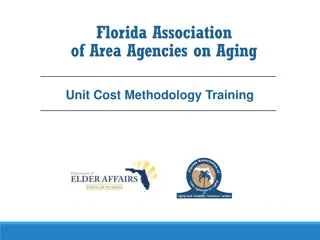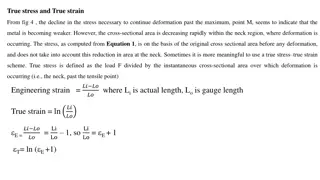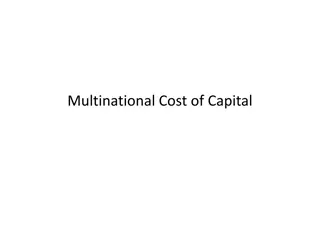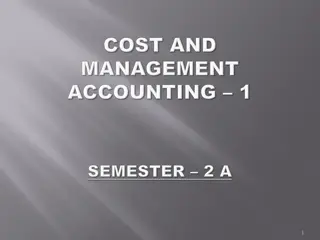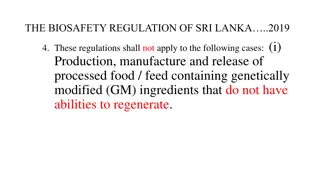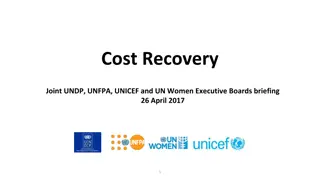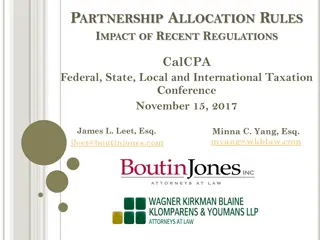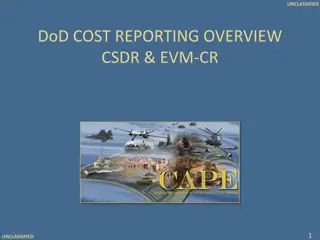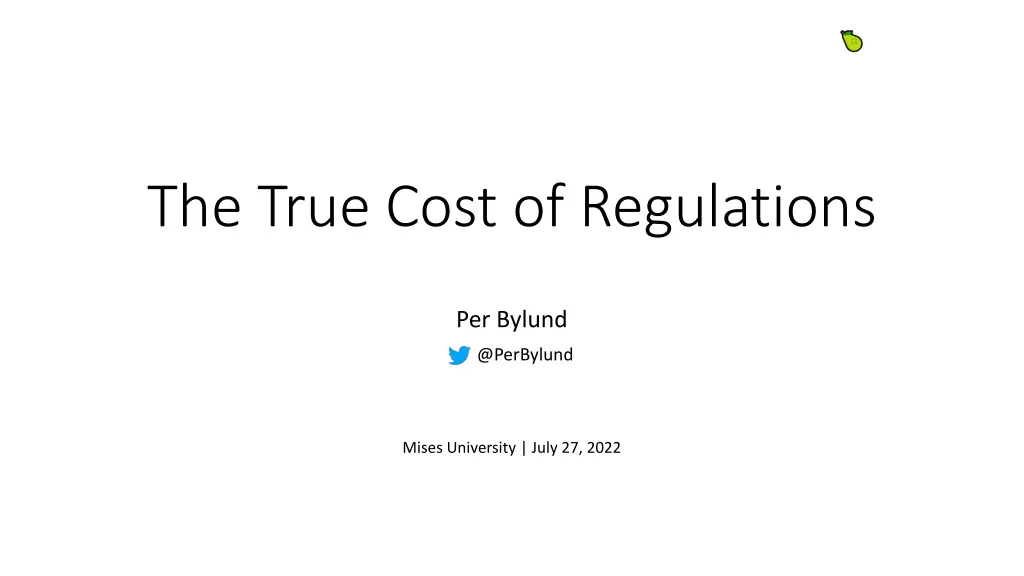
Understanding the Economic Impact of Regulations
Explore the true costs of regulations, how to study them, the importance of considering the seen vs. unseen effects, and what's missing in mainstream analysis – all from a theoretical and entrepreneurial perspective. Discover the significance of long-term effects, proper economic theory, subjective value, market processes, entrepreneurship, and economic calculation. Gain insights from renowned economists and learn to analyze regulations comprehensively for better decision-making.
Uploaded on | 1 Views
Download Presentation

Please find below an Image/Link to download the presentation.
The content on the website is provided AS IS for your information and personal use only. It may not be sold, licensed, or shared on other websites without obtaining consent from the author. If you encounter any issues during the download, it is possible that the publisher has removed the file from their server.
You are allowed to download the files provided on this website for personal or commercial use, subject to the condition that they are used lawfully. All files are the property of their respective owners.
The content on the website is provided AS IS for your information and personal use only. It may not be sold, licensed, or shared on other websites without obtaining consent from the author.
E N D
Presentation Transcript
The True Cost of Regulations Per Bylund @PerBylund Mises University | July 27, 2022
How can we study regulations? Statistically Captures actual magnitudes Lacks counterfactual Retrospective Theoretically Lacks magnitudes Provides short- and long-term counterfactuals Future-oriented Mises University. "The True Cost of Regulations." 7/27/2022
Mainstream analysis (overview) Comparative analysis of the social costs/benefits of a policy Ex ante: status quo extrapolated into the future vs. made-up alternate reality Ex post: empirical data vs. made-up alternate reality Relies on prices, real and estimated, as representative of (social) value Synthetic controls and statistical inferences Statistical estimates and comparison of the short-term seen and the unseen. Mises University. "The True Cost of Regulations." 7/27/2022
The seen vs. unseen Between a good and a bad economist this constitutes the whole difference the one takes account of the visible effect; the other takes account both of the effects which are seen, and also of those which it is necessary to foresee. Now this difference is enormous, for it almost always happens that when the immediate consequence is favourable, the ultimate consequences are fatal, and the converse. Hence it follows that the bad economist pursues a small present good, which will be followed by a great evil to come, while the true economist pursues a great good to come, at the risk of a small present evil. Fr d ric Bastiat Mises University. "The True Cost of Regulations." 7/27/2022
The seen vs. unseen: a restatement The bad economist sees only what immediately strikes the eye; the good economist also looks beyond. The bad economist sees only the direct consequences of a proposed course; the good economist looks also at the longer and indirect consequences. The bad economist sees only what the effect of a given policy has been or will be on one particular group; the good economist inquires also what the effect of the policy will be on all groups. Henry Hazlitt Mises University. "The True Cost of Regulations." 7/27/2022
Whats missing in mainstream Consideration of long-term effects Proper economic theory How entrepreneurs make money Mises University. "The True Cost of Regulations." 7/27/2022
Proper economic theory Subjective value Market process Entrepreneurship Economic calculation Mises University. "The True Cost of Regulations." 7/27/2022
A theoretical study of regulations What is a regulation? How does it affect human action? People s (producers and consumers) value scales? What is its economic impact? Short term and long term Effect on entrepreneurship, production, economic calculation Mises University. "The True Cost of Regulations." 7/27/2022
How do regulations relate to destruction? Mises University. "The True Cost of Regulations." 7/27/2022
Large-scale destruction Assume bombs dropped over Dresden with massive property damage, but no deaths (a miracle!) Before After Big boy Buildings Buildings Other stuff Other stuff As the bombing stops, people get busy rebuilding More economic activity (what Krugman calls growth ) Mises University. "The True Cost of Regulations." 7/27/2022
Large-scale destruction contd The higher demand for construction materials causes prices to increase Construction materials are shifted into Dresden from lower-priced regions in pursuit of profits Increased production in existing supply chains In other words: the market works as expected Disaster relief offered by private citizens, charitable and for-profit organizations, maybe also government Dresdeners have suffered a loss, but they still pursue their highest valued attainable ends Mises University. "The True Cost of Regulations." 7/27/2022
Economics of destruction Temporary loss/setback Loss of existing wealth (window, Dresden) Prices and actions adjust to the new situation Resources are reallocated to their better uses Despite the exogenous shock (destruction), the market order remains intact Actors pursue their highest valued attainable ends A temporary setback (loss), followed by the (new) maximizing trajectory Mises University. "The True Cost of Regulations." 7/27/2022
How are regulations different? Mises University. "The True Cost of Regulations." 7/27/2022
Regulations Restrictions (costs imposed) on actions Prohibition on specified actions (bans) Prohibition on actions unless complying with specific mandates (licensing, zoning, building codes etc.) Effective regulations restrict/prohibit actions that are formally, physically, and economically feasible Regulations are not destruction, but destructive Mises University. "The True Cost of Regulations." 7/27/2022
Regulations: value scale analysis Assume the CDC issued a touchscreen ban in 2006 to stop the spread of some disease Mises University. "The True Cost of Regulations." 7/27/2022
Dr. Anthony iPad Fauci Mises University. "The True Cost of Regulations." 7/27/2022
Regulations: value scale analysis Assume the CDC issued a touchscreen ban in 2006 to stop the spread of some disease This is the effect on some user s value scale: No regulation Touchscreen ban iPod Touch iPod Touch Walkman Walkman Portable radio Portable radio Mises University. "The True Cost of Regulations." 7/27/2022
Regulations: value scale analysis Note the implication: this is not a one-time loss Reality is unchanged the economy s ability to satisfy this want remains The option is lost Someone to replace a broken device cannot Someone frequently updating their device cannot Actors can t pursue their highest valued attainable ends Every time a choice is made where the touchscreen option had been valued higher constitutes a loss The economy is not static, it is a process restrictions have long-term consequences Mises University. "The True Cost of Regulations." 7/27/2022
Regulations: production analysis Producers are prohibited from selling touchscreens, so they will exit or shift production elsewhere Relative consumer wants, there is under-production in touchscreens and devices using touchscreens Investments are instead made elsewhere: non-touchscreen devices, television sets, etc. Relative consumer wants, there is over-production in other lines of production In sum, the production structure is distorted, malinvestments abound Mises University. "The True Cost of Regulations." 7/27/2022
So far, no big surprises Regulations distort the production structure Regulations cause value losses (lost options) So, what about the unrealized ? Mises University. "The True Cost of Regulations." 7/27/2022
Innovation is (r)evolutionary Time iPod iPhone iPad Innovations are cumulative, so where capital investments are made matters: they determine (facilitate) what entrepreneurs can do Process perspective: effects in the unfolding market Mises University. "The True Cost of Regulations." 7/27/2022
Implications of touchscreen ban No continued innovation using touchscreens to satisfy consumer wants Resources reallocated toward other (lesser) value production Relevant knowledge and competencies will not be developed, generated, accumulated Jobs, expertise, organizations will not be created They may be created elsewhere (a further distortion) Add-on and next-stage investments/firms/jobs will never see the light of day Mises University. "The True Cost of Regulations." 7/27/2022
The unrealized Neither seen nor unseen, but what never comes to be because of regulations The products, investments, jobs, and opportunities that would have existed were it not for artificial restrictions (regulations) Where the market would be, structurally, from a consumer satisfaction perspective options that would have been available had the economy not been distorted (p. 162) Regulations do away with products but, more importantly, also jobs/careers, production possibilities, and value-creative trajectories Mises University. "The True Cost of Regulations." 7/27/2022
Summing up Economic effects are distorted processes and trajectories Misaligned production structure Destruction of capital is no biggie, comparatively speaking Temporary setback, but production structure aligned with cons. wants (Even libertarians don t understand how destructive regulations are!) Mises University. "The True Cost of Regulations." 7/27/2022
Analyzing the Unrealized Sweatshops Mises University. "The True Cost of Regulations." 7/27/2022
Analyzing the Unrealized the fact that there are no economic limitations means the market is mature enough to support this type of production [sweatshops]. We can therefore conclude that the standard of living in the village would likely have been at par with that which is offered through employment in the sweatshop. In other words, the poverty experienced by the villagers is to a significant extent artificial, as is Rashid s choice situation when he chooses between the comparatively high-paying job in the sweatshop and toiling in the fields or weaving baskets by hand. (p. 163) Mises University. "The True Cost of Regulations." 7/27/2022
The Unrealized summarized Effect on entrepreneurs Cannot pursue creating goods and services they expect will best satisfy consumers wants Cannot make the most highly valued investment May choose to not invest at all May choose to invest elsewhere, thereby distorting the production structure This means lower standard of living Fewer and worse options for consumers Fewer and lower-pay jobs for workers Production structure not aligned with consumer value Mises University. "The True Cost of Regulations." 7/27/2022
Read more The Seen, the Unseen, and the Unrealized: How Regulations Affect Our Everyday Lives https://store.mises.org /The-Seen-the-Unseen- and-the-Unrealized- P11174.aspx Mises University. "The True Cost of Regulations." 7/27/2022

